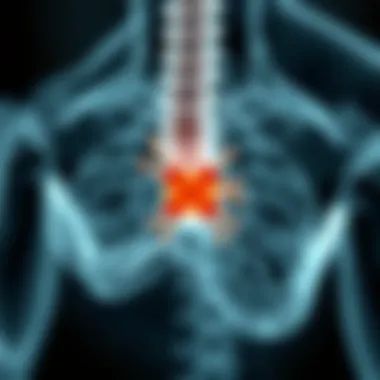Rheumatism vs. Rheumatoid Arthritis: Key Differences


Intro
When discussing joint pain and inflammation, two terms often pop up: rheumatism and rheumatoid arthritis. While many people tend to use these phrases interchangeably, it's crucial to grasp the key distinctions as they represent different conditions. Acknowledging these differences can significantly enhance both clinical practices and patient care. In this article, we’ll dissect their definitions, symptoms, underlying causes, and the various treatment options available.
With a clearer understanding of how rheumatism relates to rheumatoid arthritis, the expectations surrounding diagnosis and management change. This article serves as a roadmap, guiding students, researchers, educators, and professionals through the intricate landscape of rheumatological disorders. Whether you’re looking to deepen your knowledge for academic purposes or seeking insights for practical application in healthcare settings, this analysis should serve as a comprehensive resource.
As we dive deeper into the topic, we’ll take a closer look at the methodology employed to synthesize the information and the discussion surrounding the implications of our findings. Rather than gloss over these important aspects, we strive to provide a detailed narrative that prioritizes both clarity and depth. Let's roll up our sleeves and get started!
Defining Rheumatism
Defining rheumatism is essential for distinguishing it from rheumatoid arthritis in medical discussions. There's a prevailing notion that all rheumatic diseases fall under a single umbrella term, which can lead to confusion. This distinction is particularly relevant for students, researchers, and healthcare professionals who seek a deeper comprehension of these conditions. Rheumatism is often associated with various ailments that cause inflammation in the joints and connective tissues, rather than being a singular diagnosis.
Rheumatism encompasses a variety of conditions, and recognizing its breadth is crucial for understanding how it interacts with specific diseases like rheumatoid arthritis. The symptoms, treatments, and overall patient experience can vary significantly across this spectrum. Knowing the nuances helps create targeted treatment strategies and encourages more informed discussions among those in the medical field.
In essence, education on rheumatism not only clarifies terminology but also paves the way for enhanced patient care. When healthcare providers possess a comprehensive understanding of rheumatism, they can better diagnose, treat, and guide patients through appropriate interventions.
Historical Context
The term "rheumatism" has roots in the ancient world, often associated with conditions that caused joint pain and inflammation. In fact, Greek physicians referred to it as a fluid-based disturbance within the body that led to discomfort and swelling. Over the years, the understanding of rheumatism has evolved. By the 19th century, it became more formally categorized within medical texts, differentiating between types of rheumatic diseases.
Early interpretations often conflated rheumatism with other diseases, presenting a challenge for accurate diagnosis. As medical science progressed, it was recognized that rheumatism includes numerous disorders. Conditions such as osteoarthritis, lupus, and gout were identified and located within the broader rheumatism classification.
Current Medical Understanding
Today, the medical community recognizes rheumatism as a collection of disorders characterized by pain and inflammation primarily affecting the joints, tendons, and muscles. This expansive view allows for a more precise approach in both diagnosis and treatment. Clinicians utilize specific criteria to differentiate between rheumatic conditions, drawing upon lab tests, imaging, and patient histories.
It's important to note that while all these conditions may share common symptoms like pain and swelling, they may demand entirely different management approaches. For example, treatments for osteoarthritis focus on pain relief and improving mobility, whereas autoimmune-related forms of rheumatism require immunosuppressive therapies.
In summary, the current understanding of rheumatism not only acknowledges its complexity but also prompts ongoing research. The medical field is increasingly aiming to personalize care strategies for those afflicted by rheumatism, enhancing both treatment efficacy and patient outcomes.
Understanding Rheumatoid Arthritis
Understanding rheumatoid arthritis is crucial for distinguishing it from rheumatism, as it highlights the specific pathological processes, symptoms, and therapies involved. This condition can wreak havoc on a person’s day-to-day life, impacting not just their physical well-being but also mental and emotional health. By diving into the specifics, healthcare providers, patients, and their families can better navigate the complexities surrounding this autoimmune disorder.
Etiology of Rheumatoid Arthritis
Rheumatoid arthritis (RA) is a multifactorial disease, which means it arises from a mix of genetic, environmental, and immunological factors. Studies suggest that certain individuals have a genetic predisposition to develop RA, often influenced by specific HLA-DRB1 genes. Moreover, environmental triggers, such as smoking and exposure to certain pathogens, could act as catalysts in susceptible individuals, kick-starting the autoimmune response.
- Genetic Factors: It's well-documented that family history plays an important role. If a close family member has RA, the chances of developing the condition leap considerably.
- Hormonals Influence: The rise in incidence among women, especially post-menopause, leads researchers to believe hormones may also be significant. Estrogen’s impact on immune response could be a key piece of this puzzle.
- Environmental Triggers: Specific infections might act as a trigger for some. For instance, certain viruses have been linked in studies but their roles remain a subject of ongoing research.
"Understanding the etiology of rheumatoid arthritis is crucial for early diagnosis and intervention, leading to better patient outcomes."
Pathophysiology
The pathophysiology of rheumatoid arthritis revolves around chronic inflammation and subsequent joint damage due to immune system malfunction. In simple terms, the body’s immune system, which normally protects against pathogens, mistakenly attacks the synovial membranes in the joints.
- Joint Inflammation: This is where the rubber meets the road. The synovial membrane thickens and produces excess synovial fluid, leading to swollen joints that cause pain and stiffness. Over time, this inflamed tissue can lead to joint deformities and impaired function.
- Systemic Effects: It’s not just about the joints. RA can affect other systems in the body, leading to complications in the lungs, heart, and blood vessels. This aspect only heightens the importance of understanding RA in its entirety.
- Cytokine Imbalance: Pro-inflammatory cytokines, such as TNF-alpha and IL-6, play perhaps the most significant role in this disorder. Their overproduction exacerbates inflammation, leading to further joint degradation and systemic symptoms.
Overall, having a firm grasp of the etiology and pathophysiology of rheumatoid arthritis paves the way for timely and effective treatment strategies. The ultimate goal is to manage symptoms, reduce inflammation, and maintain joint function to improve quality of life.
Primary Differences Between Rheumatism and Rheumatoid Arthritis
Understanding the distinctions between rheumatism and rheumatoid arthritis is central to making informed decisions regarding diagnosis, treatment, and patient care. Misunderstanding these two conditions can lead to inappropriate management strategies, ultimately affecting patient outcomes. It’s crucial for healthcare professionals, educators, and researchers to recognize these differences, as it fosters a more accurate conceptualization of these diseases, enhancing clinical practice and therapeutic approaches.
Symptom Variability
Rheumatism and rheumatoid arthritis can present a confusing patchwork of symptoms that vary significantly from one individual to another. Rheumatism, as a general term, can refer to a range of conditions that affect joints and connective tissues. This umbrella category encompasses an array of diseases, resulting in symptoms that can include joint pain, stiffness, and swelling. However, these manifestations may not always indicate specific underlying pathologies.
In contrast, rheumatoid arthritis is a specific autoimmune disease marked by its chronic inflammation patterns. The symptoms are often more pronounced, with patients experiencing consistent joint pain and noticeable swelling, particularly in hands, wrists, and feet. A hallmark of this condition is its symmetrical nature; if one knee is affected, the other often will be too.
- Rheumatism symptoms may include:
- Rheumatoid arthritis symptoms typically involve:
- General joint pain and softness.
- Fatigue and malaise.
- Episodes of swelling, sometimes transient.
- Persistent inflammation leading to deformity.
- Morning stiffness lasting longer than an hour.
- Extra-articular manifestations, such as fever or fatigue, may also occur.
It's essential to remember that symptom variability also hinges on several factors, including age, lifestyle, and the presence of co-morbid conditions. Patients experiencing different symptoms may require tailored treatment strategies and careful monitoring.
Disease Classification
The classification of rheumatism and rheumatoid arthritis rests on several foundational differences. Rheumatism is a broad term used in both clinical and lay contexts, often lacking the specificity needed for a definitive diagnosis. It can mislead patients into thinking they share a single condition, while in reality, it encompasses various diseases.


Rheumatoid arthritis, on the other hand, falls under the banner of autoimmune diseases, where the immune system mistakenly attacks healthy tissue. It is classified specifically based on its pathophysiological and clinical characteristics.
- Rheumatism might be classified into:
- Rheumatoid arthritis is classified with considerations of:
- Osteoarthritis, affecting cartilage.
- Gout, associated with uric acid.
- Psoriatic arthritis, linked with psoriasis.
- Laboratory tests like rheumatoid factor (RF) and anti-citrullinated protein antibodies (ACPA).
- Imaging results that reveal characteristic joint erosion.
- The clinical course, often categorized as seropositive or seronegative.
Differentiating between these classifications is not just an academic exercise; it holds practical ramifications for patient care. A miscategorization could lead to ineffective treatments or mismanagement of the disease. It is vital for clinicians to have a comprehensive understanding of these classifications to ensure appropriate interventions.
In summary, the differences between rheumatism and rheumatoid arthritis in terms of symptoms and classifications are crucial for effective patient diagnosis and management, marking a straight path towards improved care.
Common Symptoms of Rheumatism
When it comes to rheumatism, recognizing its common symptoms is paramount, not just for the diagnosis but also for understanding the overall impact on those affected. Rheumatism is an umbrella term encompassing a range of musculoskeletal disorders, and deciphering its symptoms can be a tricky business.
Understanding these indicators can lead to more timely and effective management strategies, ultimately improving a patient's quality of life.
Joint Pain and Inflammation
One of the hallmark signs of rheumatism is, without a doubt, joint pain and inflammation. This isn’t just your run-of-the-mill ache; it's a persistent, nagging pain that can wake people from sleep or hinder them from their daily activities. Joints, including knees, elbows, and wrists, are common battlegrounds. For many, the pain can be constant, while others experience painful flare-ups.
The inflammation that accompanies the pain often results in rigidity, especially noticeable in the morning or after long periods of inactivity. This kind of stiffness usually dissipates with movement but can return quickly if the person remains sedentary. For instance, many individuals find they can’t fully extend their arm or leg without difficulty, which disrupts their ability to perform everyday tasks like reaching for an item on a high shelf or putting on shoes.
"Joint pain and swelling aren't just nuisances; they can signify deeper issues in the body that merit prompt attention."
Systemic Manifestations
Beyond the joints, rheumatism can lead to systemic manifestations that affect the whole body. Fever, fatigue, and malaise may emerge as the body responds to inflammatory processes. Individuals might feel like they’re trudging through molasses, unable to muster the energy for even the simplest of tasks. This overall tiredness often leaves individuals bewildered, as they may not immediately connect their fatigue with their joint symptoms.
In some cases, additional symptoms such as weight loss, weakness, or even skin rashes may present, indicating that rheumatism isn’t solely a local issue but rather part of a larger inflammatory response affecting other organs. This intertwining of symptoms complicates the clinical picture, necessitating a multi-faceted approach to treatment.
Given that these systemic manifestations can overlap with various other health conditions, differentiating them can be perplexing. Health professionals delve into a patient’s entire symptomatology, often looking for patterns or unusual symptoms that deviate from traditional presentations. This crucial assessment can assist in narrowing down a diagnosis and guiding appropriate treatment options.
In summary, recognizing the common symptoms of rheumatism, particularly joint pain and systemic manifestations, can steer patients towards early detection and management. This focus on symptoms is not merely academic but impacts the life quality of real individuals grappling with these considerable challenges. Conversations about symptoms can often feel overwhelming, but they lay the groundwork for effective, personalized care.
Common Symptoms of Rheumatoid Arthritis
Understanding the common symptoms of rheumatoid arthritis is crucial for both patients and healthcare providers. Early recognition of these symptoms can lead to timely interventions, potentially improving outcomes and enhancing quality of life. Rheumatoid arthritis isn't just a static condition; it evolves, often complicating diagnosis and treatment. This complexity necessitates a comprehensive grasp of the symptoms associated with it.
Chronic Inflammation Patterns
Chronic inflammation is the hallmark of rheumatoid arthritis, a key factor that distinguishes it from other rheumatic conditions. The body’s immune system, instead of protecting, turns against itself, leading to persistent inflammation primarily in the joints. This inflammation can appear and recede in cycles, which tends to confuse individuals trying to assess their condition.
The most visible sign of this inflammation is often joint swelling, especially in the hands and feet. Morning stiffness lasting more than an hour is another common complaint. Those affected might notice their joints feel warm or tender to the touch, which is a direct result of the immune response inflaming the synovial membrane surrounding these joints.
In recent studies, researchers have noted that besides the joints, chronic inflammation may also contribute to systemic complications, affecting various body systems. Keeping an eye on red flags such as fatigue, fever, and unintentional weight loss can assist in monitoring the disease progression and adjusting treatment plans accordingly.
It’s essential for patients to communicate any changes in their inflammation patterns to their healthcare provider.
Extra-Articular Symptoms
Rheumatoid arthritis isn't confined to the joints. A range of extra-articular symptoms can manifest, indicating the systemic nature of the disease. These symptoms can vary greatly in severity and can affect many bodily systems, leading to an increase in overall discomfort and diminished life quality.
Some common extra-articular symptoms include:
- Fatigue: A pervasive feeling of tiredness that doesn't improve with rest.
- Fever: A mild rise in temperature often accompanies inflammation.
- Anemia: Many individuals experience low red blood cell counts due to chronic disease processes.
- Nodules: Subcutaneous nodules can develop, usually around pressure points, and can vary in size and number.
- Eye Issues: Conditions like scleritis or dry eyes are common among rheumatoid arthritis patients.
Feeling overwhelmed with these varied symptoms is normal. The interplay between joint-related and systemic manifestations underscores the multi-faceted nature of rheumatoid arthritis. Regular screenings and check-ups can aid in identifying new or worsening symptoms, allowing for an adaptable treatment approach tailored to individual needs.
Diagnostic Approaches
In the realm of rheumatology, understanding how to diagnose rheumatism and rheumatoid arthritis is pivotal. Accurate diagnosis can make a world of difference in managing both conditions effectively. This section delves into laboratory testing and imaging techniques, two fundamental components of the diagnostic toolbox that can provide essential insights into these often-conflated diseases.
Laboratory Testing
Laboratory tests serve as a cornerstone in diagnosing rheumatism and rheumatoid arthritis. These assessments can help identify underlying autoimmune responses and inflammation, guiding healthcare professionals towards accurate diagnosis and appropriate treatment plans. Here are several key laboratory tests commonly utilized:
- Rheumatoid Factor (RF): This antibody is present in many people with rheumatoid arthritis but can also appear in other autoimmune diseases and even in some healthy individuals. A positive RF test is not definitive but provides clues.
- Anti-Citrullinated Protein Antibodies (ACPAs): The presence of these antibodies is specifically associated with rheumatoid arthritis, often earlier in the disease course, making them crucial for diagnosis.
- Erythrocyte Sedimentation Rate (ESR): This test measures inflammation in the body. While it can’t pinpoint the exact cause, a high ESR can indicate that an inflammatory process is underway.
- C-reactive Protein (CRP): Similar to the ESR, CRP levels rise when there is inflammation. It can also help monitor the effectiveness of treatments.
These tests are not isolated events; they contribute to a larger discussion within the clinical setting. The interpretation of results usually demands a nuanced understanding of the patient’s overall health, symptoms, and medical history. It’s not uncommon for doctors to consider multiple tests together to avoid misdiagnosis.
With advancements in precision medicine, laboratories are also developing newer biomarkers that might play a role in more refined diagnoses in the future, pushing research and clinical practice to more effective levels of treatment.


"Accurate lab testing doesn't just provide results; it refines the path—guiding patients towards effective interventions and ultimately better outcomes."
Imaging Techniques
Imaging techniques are another vital aspect of diagnosing both rheumatism and rheumatoid arthritis. They provide visualization of the joints and surrounding tissues, revealing damage and inflammatory processes that may not be apparent in physical examinations or laboratory tests alone. Here’s a look at some commonly employed imaging methods:
- X-rays: Traditionally, X-rays are the first line of imaging to assess joint damage or erosion caused by rheumatoid arthritis. They can reveal changes in bone structure over time, informing treatment decisions and disease progression.
- Ultrasound: Increasingly popular in rheumatology, ultrasound can detect synovitis—an inflammation of the synovial membrane—as well as erosions early in the disease course. This method is non-invasive and allows real-time observation of joint dynamics.
- Magnetic Resonance Imaging (MRI): MRI offers detailed images of soft tissues and bone structures. It is particularly useful for diagnosing early stages of rheumatoid arthritis and assessing damage without exposure to radiation.
While imaging techniques are quite informative, they also come with considerations. For instance, not all imaging methods are equally accessible; factors such as cost, availability, and the need for specialized equipment can influence their use.
These imaging advances not only enhance the diagnostic process but also facilitate ongoing monitoring and evaluation of treatment efficacy. Understanding the interplay between various diagnostic approaches allows for a comprehensive view, ultimately benefiting patient outcomes.
Treatment Strategies for Rheumatism
Understanding the treatment strategies for rheumatism is pivotal within the context of this article, as it offers insights into managing a condition that can greatly impact the quality of life. The approach to treating rheumatism is often multifaceted, encompassing both non-pharmacological interventions and pharmacotherapy. By exploring these methods, we aim to highlight therapies that can alleviate symptoms, enhance physical function, and ultimately improve life for those affected.
Non-Pharmacological Interventions
Non-pharmacological interventions play a crucial role in the management of rheumatism. These strategies emphasize lifestyle modifications and physical therapies rather than medications. Potential approaches include:
- Physical Activity: Engaging in regular, moderate exercise is beneficial. Swimming, walking, and stretching can help maintain joint function and reduce stiffness. Tailoring activities to individual needs is essential for maximizing benefits.
- Physical Therapy: Professional physical therapists can design personalized exercise programs to strengthen muscles around the joints, which may offer additional support and reduce pain.
- Weight Management: Maintaining a healthy weight can significantly lessen the burden on weight-bearing joints. Losing even a small amount of weight can lead to notable improvements in mobility and comfort.
- Hot and Cold Therapy: Applying heat can alleviate pain and improve circulation, whereas cold packs can reduce inflammation and numb sharp pain. Finding the right balance between these therapies can be useful.
- Stress Management: Techniques such as yoga, meditation, or mindfulness can help reduce stress, which may exacerbate symptoms. Numerous patients have found relief through these calming practices, aiding in both mental and physical health.
These interventions, while often overlooked, can provide significant relief without the side effects associated with medications, making them valuable in tailored treatment plans.
Pharmacotherapy
Pharmacotherapy encompasses medicinal treatments that can relieve the symptoms associated with rheumatism. The type of medication prescribed will depend on the severity and specific symptoms presented. Here are common categories of pharmacological treatments:
- Non-Steroidal Anti-Inflammatory Drugs (NSAIDs): Medications like ibuprofen or naproxen are frequently prescribed. They can help reduce pain and inflammation, making daily activities more manageable.
- Corticosteroids: For flare-ups, corticosteroids can be effective in quickly reducing inflammation. However, long-term use may have unwanted side effects and should be monitored closely by a healthcare professional.
- Disease-Modifying Antirheumatic Drugs (DMARDs): While typically associated with rheumatoid arthritis, some DMARDs are used for rheumatism as well, aimed at slowing disease progression and preventing joint damage.
- Biologics: Tailored to target specific components of the immune system, biologics can be beneficial in treating the underlying inflammation associated with rheumatism. Evidence indicates they may offer an edge in cases where traditional therapies have not provided sufficient relief.
It's vital that individuals discuss the risks and benefits of these medications with their healthcare provider, ensuring a comprehensive treatment strategy that aligns with their health goals.
"Complementary approaches alongside pharmacotherapy often yield better outcomes in managing rheumatism, highlighting the importance of a well-rounded treatment strategy."
Treatment Modalities for Rheumatoid Arthritis
The importance of understanding treatment modalities for Rheumatoid Arthritis cannot be overstated. Managing this chronic autoimmune condition effectively is crucial not only to alleviate symptoms but also to improve the overall quality of life for patients. As the journey through rheumatoid arthritis unfolds, patients and healthcare providers alike must navigate a myriad of treatment options. It's not just about tackling joint pain; it's about preventing long-term damage and improving functional outcomes. Knowing when and how to use various treatments is key, as is understanding the potential side effects and personalizing therapy to fit individual needs.
Disease-Modifying Antirheumatic Drugs (DMARDs)
Disease-Modifying Antirheumatic Drugs, commonly known as DMARDs, play a pivotal role in the management of rheumatoid arthritis. These medications aim to slow down the progression of the disease and prevent joint damage. Among the more traditional DMARDs, methotrexate is the most widely prescribed; however, there are others like sulfasalazine and leflunomide.
- Mechanism of Action: DMARDs work by modifying the immune system's response, ultimately decreasing inflammation and the autoimmune attack on the joints. This process can take weeks to months to manifest significant effects, requiring patience on the part of both patient and clinician.
- Benefits: One of the most notable advantages of DMARDs is their ability to halt disease progression. They not only relieve symptoms but also significantly reduce the risk of joint erosion, which can lead to lifelong disability.
- Considerations: Despite their benefits, DMARDs are not without side effects. Common issues can include gastrointestinal problems, liver toxicity, and bone marrow suppression. Therefore, regular monitoring through blood tests is crucial to ensure patient safety and adjust dosages accordingly.
"The right DMARD can make all the difference, turning the tide against rheumatoid arthritis and allowing for improved function and reduced pain."
Biologic Agents and Targeted Therapies
As the understanding of rheumatoid arthritis has evolved, so too has the treatment landscape, leading to the development of biologic agents and targeted therapies. These newer modalities represent a significant advancement in the fight against this debilitating condition.
- What Are Biologics?: Biologics are genetically engineered proteins derived from living cells that target specific components of the inflammatory process. They work on pathways that are responsible for the inflammation and joint damage characteristic of rheumatoid arthritis.
- Targeted Therapies: Unlike traditional DMARDs, which affect the overall immune system, targeted therapies focus on distinct pathways or molecules within the immune response. For example, TNF inhibitors such as infliximab and adalimumab block the tumor necrosis factor, a key player in systemic inflammation.
- Efficacy: Many patients experience rapid improvements in symptoms and disease markers when using biologics. They tend to be especially beneficial for those who do not respond adequately to conventional DMARD therapy.
- Risks and Warnings: While biologics can offer significant benefits, they also come with risks. These treatments can increase susceptibility to infections and may require monitoring for malignancies. Additionally, they are often quite expensive, raising questions regarding accessibility and insurance coverage.
Long-Term Prognosis and Outcomes
Understanding the long-term prognosis and outcomes associated with rheumatism and rheumatoid arthritis is essential for grasping how these conditions impact patients over time. It is not just about the immediate symptoms but how they affect the lives of individuals down the line. The prognosis can vary significantly between these two conditions, with multiple factors at play, including the age of onset, treatment adherence, and overall health.
The long-term implications can shape a patient's outlook, both physically and mentally. Insight into prognosis informs treatment strategies, helps manage expectations, and aids healthcare providers in making more informed clinical decisions. Thus, exploring these elements not only enhances medical practice but also empowers patients to participate effectively in their own health journey.
Rheumatism Prognosis
The prognosis for rheumatism can be somewhat unpredictable. For many individuals, rheumatism represents a general umbrella term for rheumatic diseases, including but not limited to arthritis, fibromyalgia, or even chronic pain syndromes. As a result, outcomes can vary widely by the specific condition in question.
The key factors influencing prognosis include:
- Type of Rheumatism: Different forms may have different trajectories. For instance, someone with fibromyalgia might experience chronic pain but may not develop severe joint damage, while another with seronegative arthritis may face worsening joint issues over time.
- Treatment Response: Success of non-pharmacological interventions like physical therapy or dietary changes can dictate long-term outcomes. Patients who engage proactively with their treatment often note improvements in their quality of life.
- Coexisting Conditions: The presence of other health issues, like obesity or diabetes, can complicate the picture, potentially worsening rheumatism and leading to more significant disability.
- Lifestyle Choices: Smoking, exercise, and diet play critical roles. Better health choices typically lead to better outcomes; think of it as you reap what you sow.
Rheumatoid Arthritis Prognosis
When considering rheumatoid arthritis, the prognosis is often clearer but remains complex due to its multifaceted nature. Unlike general rheumatism, rheumatoid arthritis is an autoimmune condition characterized by chronic joint inflammation. Understanding its course is vital for making well-informed decisions about management.
Some significant aspects include:
- Early Intervention: Research shows that starting treatment early can drastically improve outcomes. Patients who receive timely and appropriate treatment may achieve better functional status and lower disease progression.
- Joint Damage: This is a crucial concern. If left untreated, rheumatoid arthritis can lead to irreversible joint damage. Regular monitoring is essential to detect changes early.
- Long-Term Effects: It can lead to systemic issues beyond just joints, affecting organs like the heart and lungs. Management plans must consider these possibilities, thus improving holistic care.
- Patient Empowerment: Engaged patients who actively manage their condition often report a higher quality of life. Support groups and education can enhance a patient's ability to cope effectively.


The long-term outlook in both rheumatism and rheumatoid arthritis emphasizes the importance of continued monitoring and proactive management strategies.
By summarizing the long-term prognosis for rheumatism and rheumatoid arthritis, it becomes clear that their management requires a tailored approach, emphasizing the unique aspects of each condition. Monitoring progress, responding to treatment strategies, and supporting a patient's overall well-being can lead to significantly improved outcomes.
Impact on Patient Quality of Life
The impact on patient quality of life is a central theme within rheumatism and rheumatoid arthritis discussions. Both conditions, while distinct, share common threads that significantly influence how individuals navigate their daily lives. Addressing the quality of life issues linked to these ailments can lead to improved understanding and management strategies that healthcare providers can adopt. Patients often face physical limitations, emotional stress, and social challenges that stem from these diseases. The consideration of quality of life is not just about understanding the disease itself but also about fostering a holistic approach to treatment and support.
Physical Functioning
Physical functioning is a cornerstone of daily life for individuals with rheumatism and rheumatoid arthritis. The degrees to which these conditions impact mobility, strength, and overall bodily function can vary widely. Patients often experience joint pain, stiffness, and fatigue that impair their ability to engage in both basic and complex activities.
In many instances, these physical challenges lead to:
- Reduced Mobility: Patients may find themselves unable to perform simple tasks like walking, climbing stairs, or even getting out of bed without assistance.
- Loss of Independence: The struggle to manage daily activities can lead to reliance on caregivers or assistive devices, which can further affect one’s sense of autonomy.
- Physical Activity Limitations: Individuals might shy away from exercise or engaging in recreational activities due to fears of exacerbating their symptoms, thus further compounding health issues.
Maintaining functional abilities can enhance not only physical health but also boost self-esteem. Practical approaches, such as physical therapy, can be crucial in helping individuals adapt to their limitations while promoting strength and stability.
Psychosocial Aspects
The psychosocial aspects of living with rheumatism or rheumatoid arthritis cannot be overlooked. These conditions often come with emotional burdens that can heavily weigh on a patient's mental and social well-being. Feelings of depression, anxiety, or isolation can crop up alongside physical symptoms. Understanding these psychosocial components provides a broader lens through which to view the patient experience.
Some notable considerations include:
- Emotional Distress: The constant pain and unpredictability of flare-ups can lead to significant emotional strain. Many patients report feeling hopeless or frustrated as they adjust to their new reality.
- Social Isolation: Limiting social interactions due to physical constraints can foster loneliness. Friends and family may struggle to understand the condition, leading to strained relationships.
- Economic Impact: The financial burden of managing these diseases can also create stress. From treatment costs to lost wages due to inability to work, the ripple effects can feel overwhelming.
Recognizing these psychosocial aspects allows healthcare providers to offer more nuanced support, focusing not just on symptom alleviation but also on emotional and social wellness. Utilizing counseling, support groups, and integrative care strategies may prove effective in enhancing overall quality of life.
"It's not just about battling the disease; it's about reclaiming life and finding joy in the small moments."
For more insight into understanding how these conditions can alter life trajectories, you can visit the following resources:
WebMD for patient stories on managing daily life with these conditions.
National Institute of Arthritis and Musculoskeletal and Skin Diseases for further information about research and resources.
Research Trends and Future Directions
The realm of rheumatology continues to evolve, with ongoing research shedding light on the complexities of conditions like rheumatism and rheumatoid arthritis. Understanding the Research Trends and Future Directions in this field is paramount, not only for healthcare professionals but also for policymakers, researchers, and patients alike. This section emphasizes the significance of staying abreast of recent developments, which can lead to more effective treatments and improved patient outcomes.
Emerging Therapies
One noteworthy trend is the exploration of emerging therapies. Recent studies have investigated various innovative biologic agents that target specific pathways involved in inflammation. These therapies aim to not just manage symptoms but fundamentally alter the disease course. For instance, therapies targeting interleukin-6 (IL-6) and Janus kinase (JAK) pathways are showing promising results in controlling disease progression and enhancing the quality of life for patients.
Additionally, researchers are looking into the role of stem cell therapy and regenerative medicine as a potential avenue for treatment. This approach could potentially repair the damage caused by rheumatoid arthritis rather than merely treating its symptoms. The implications of such therapies could redefine the management of chronic conditions, making it essential for the medical community to keep a keen eye on these developments.
- Some emerging therapies include:
- Biologics targeting TNF-alpha.
- Interleukin inhibitors that focus on specific inflammatory pathways.
- Cellular therapies involving mesenchymal stem cells.
However, these treatments are not without their challenges. Issues such as high costs, varying patient responses, and potential long-term effects necessitate robust clinical trials and further investigation. Understanding how these therapies interact with the immune system will be crucial in refining treatment protocols.
Advancements in Diagnostic Techniques
The landscape of diagnostics is similarly undergoing a transformation. Advancements in Diagnostic Techniques are vital for differentiating between rheumatism and rheumatoid arthritis as early and accurate identification can substantially alter treatment plans and outcomes.
Recent breakthroughs have incorporated the use of advanced imaging techniques such as ultrasound and MRI, which allow for better visualization of joint inflammation and damage not discernible with traditional X-rays. Furthermore, biomarkers are emerging as tools to aid in diagnosing rheumatoid arthritis earlier and more reliably. Research on blood tests measuring specific proteins linked to inflammation could allow for quicker and more precise diagnosis.
- Notable advancements include:
- High-resolution MRI for sensitive detection of joint issues.
- Ultrasound for real-time imaging of swelling and effusion.
- Serum biomarkers indicating disease activity such as anti-CCP antibodies.
These innovations pave the way for more individualized patient care and highlight the importance of interdisciplinary collaboration in research. Enhanced diagnostic clarity not only supports timely interventions but also fosters better understanding amongst healthcare providers about distinguishing these complex conditions.
"Timely diagnosis can not only improve the effectiveness of interventions but also reduce the overall burden of the disease on patients and healthcare systems."
Wrap-Up: Key Takeaways
In this exploration of rheumatism and rheumatoid arthritis, it’s crucial to draw attention to the fundamental distinctions and overlaps between these two conditions. Understanding rheumatism as a broader term that can encompass various rheumatic diseases, including rheumatoid arthritis, allows for a more nuanced view of patient care and treatment strategies.
Summary of Findings
The analysis presented highlights several key aspects:
- Definitions and Classifications: Rheumatism generally refers to a collection of conditions affecting the musculoskeletal system, while rheumatoid arthritis is a specific autoimmune disease. This distinction is significant in both diagnosis and treatment.
- Symptoms and Manifestations: The symptoms of rheumatism can vary widely and may not always involve joints, whereas rheumatoid arthritis typically presents with chronic joint pain and inflammation, alongside systemic symptoms that can manifest elsewhere in the body.
- Diagnosis and Treatment: Diagnostic approaches vary quite a bit. While rheumatism may require a broader diagnostic net, rheumatoid arthritis relies heavily on specific biomarkers and imaging techniques for effective management. Treatment options diverge, too; rheumatoid arthritis often necessitates more aggressive interventions, including DMARDs and biologics, as opposed to the more conservative strategies sometimes used for rheumatism.
The insights gained from this analysis reaffirm the importance of precise diagnosis and tailored treatment plans, which can significantly improve patient outcomes.
Call to Action for Further Research
Moving forward, it's essential to encourage continued research in these fields. Here are some specific areas worth investigating:
- Longitudinal Studies: There is a need for long-term studies tracking the progress of both rheumatism and rheumatoid arthritis in diverse populations. Understanding how these conditions evolve over time can lead to enhanced treatment protocols.
- Treatment Efficacy: Further exploration into the effectiveness of emerging therapies and non-pharmacologic interventions will contribute to a holistic approach to management.
- Patient Education: Research focusing on the education of patients regarding their conditions can empower them to participate actively in their treatment, fostering better adherence and overall health outcomes.







